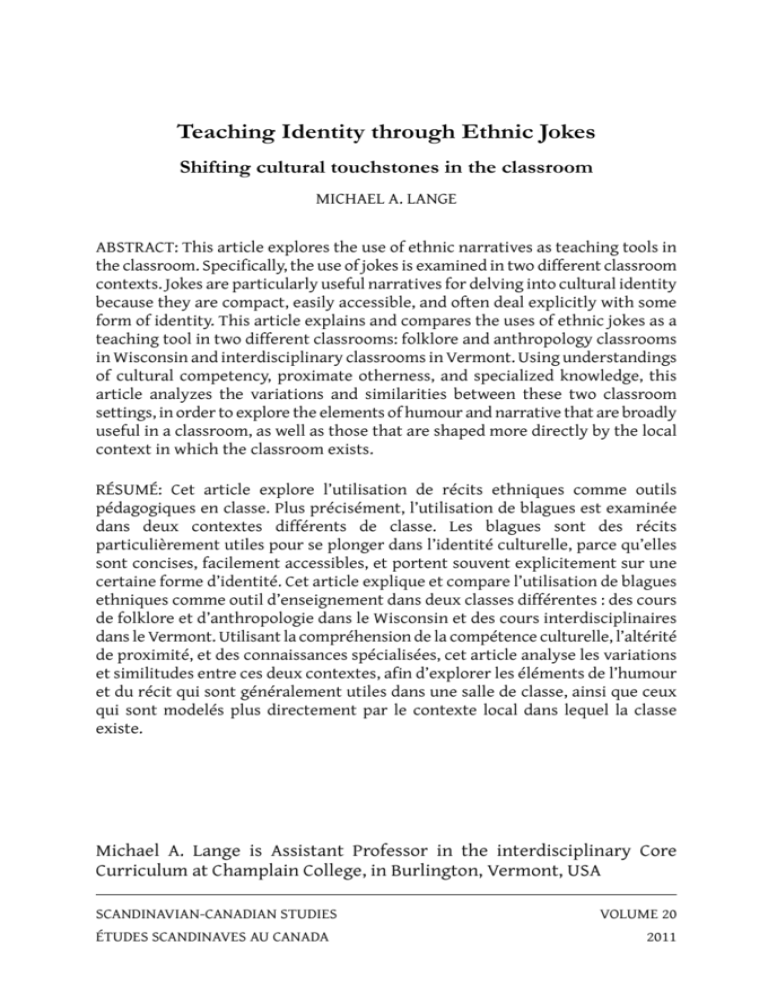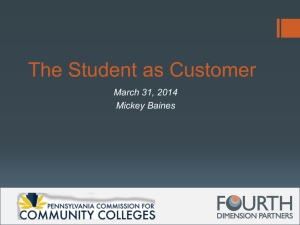Teaching Identity through Ethnic Jokes
advertisement

Teaching Identity through Ethnic Jokes Shifting cultural touchstones in the classroom MICHAEL A. LANGE ABSTRACT: This article explores the use of ethnic narratives as teaching tools in the classroom. Specifically, the use of jokes is examined in two different classroom contexts. Jokes are particularly useful narratives for delving into cultural identity because they are compact, easily accessible, and often deal explicitly with some form of identity. This article explains and compares the uses of ethnic jokes as a teaching tool in two different classrooms: folklore and anthropology classrooms in Wisconsin and interdisciplinary classrooms in Vermont. Using understandings of cultural competency, proximate otherness, and specialized knowledge, this article analyzes the variations and similarities between these two classroom settings, in order to explore the elements of humour and narrative that are broadly useful in a classroom, as well as those that are shaped more directly by the local context in which the classroom exists. RÉSUMÉ: Cet article explore l’utilisation de récits ethniques comme outils pédagogiques en classe. Plus précisément, l’utilisation de blagues est examinée dans deux contextes différents de classe. Les blagues sont des récits particulièrement utiles pour se plonger dans l’identité culturelle, parce qu’elles sont concises, facilement accessibles, et portent souvent explicitement sur une certaine forme d’identité. Cet article explique et compare l’utilisation de blagues ethniques comme outil d’enseignement dans deux classes différentes : des cours de folklore et d’anthropologie dans le Wisconsin et des cours interdisciplinaires dans le Vermont. Utilisant la compréhension de la compétence culturelle, l’altérité de proximité, et des connaissances spécialisées, cet article analyse les variations et similitudes entre ces deux contextes, afin d’explorer les éléments de l’humour et du récit qui sont généralement utiles dans une salle de classe, ainsi que ceux qui sont modelés plus directement par le contexte local dans lequel la classe existe. Michael A. Lange is Assistant Professor in the interdisciplinary Core Curriculum at Champlain College, in Burlington, Vermont, USA SCANDINAVIAN-CANADIAN STUDIES ÉTUDES SCANDINAVES AU CANADA VOLUME 20 2011 I am an anthropologist and a folklorist. I teach about identities—cultural, personal, and everything in between. In my classroom, it is often useful to make references to cultural touchstones. I used to teach at the University of Wisconsin-Madison, where many of my students had some Scandinavian ancestry, and most were at least passingly familiar with Scandinavian-American culture. When discussing tags of cultural identity, dropping a reference to the hardanger fiddle, rosemaling, or lutefisk was usually a pretty safe bet, as these are well-known markers of Scandinavian (specifically Norwegian) ethnicity in the Upper Midwestern United States. As a folklorist, I sometimes have the benefit of being able to use jokes as classroom examples because jokes are, among other things, a genre of folk speech, and one particularly suited to conveying information (such as identity) efficiently. Jokes about identity are often rife with generalizations and insulting portrayals of groups of people. Like all forms of folklore, jokes are powerful vehicles for meaning, and the messages contained within ethnic jokes can often be dangerous and damaging. However, it is the very power of the joke to convey meaning that makes it so useful as a pedagogical tool. The disciplines of folklore and anthropology both dig into the processes that make culture and identity. Neither culture nor identity is perpetually neat, clean, or pleasant. While there may be some debate about the appropriateness of telling ethnic jokes in a college classroom, there ought be no debate about using the best tools in the search to understand culture and identity. This article will (I hope) demonstrate that jokes are important and useful tools in that search. In my University of Wisconsin classrooms, I could tell Ole and Lena jokes with a fair amount of confidence that at least some of my students would recognize the names, and that most of my students would be able to situate the stereotyped characters of Ole and Lena in a Scandinavian-American context with relatively little explanation from the front of the room. To be sure, there are many ethnicities present in Wisconsin, but as Jim Leary states, “Scandinavian folk humor is the most vibrant of any ethnic group in the Upper Midwest” (63). For this reason it holds a particularly useful place in classroom discussions of identity there. Consider the following joke: This Swede went and got drunk and couldn’t find his way into the house. So he got down into the hoghouse and opened the door and lay down in the straw and went to sleep. And he woke up. He thought somebody was sleeping alongside him. It was a big sow. So he poked it with his elbow and said, Ar du Svensk? And the old sow says, Norsk, norsk. (Quoted from Leary 66) Such short texts are quite useful to unpack the relationships between various ethnic groups in Wisconsin, in this case that of Swedes and Norwegians. The 94 SCANDINAVIAN-CANADIAN STUDIES/ÉTUDES SCANDINAVES AU CANADA Swede plays the part of the lascivious drunk, which is easy to glean from the joke itself. No special cultural knowledge needs to exist in order to “get” that part of the joke—drunk people acting foolish are funny. In an Upper Midwestern context, however, more layers are easily revealed. A Wisconsin classroom is bound to have a couple students in it who realize that norsk is the Norwegian word for “Norwegian,” so that the final line, delivered in a pig-like grunt, carries double meaning. Specialized linguistic knowledge allows a fuller understanding of this joke, and that particular specialized linguistic knowledge is much more common in the Upper Midwest than in other parts of the country. Edward T. Hall, in his discussions of “high context” (HC) and “low context” (LC) communication, would classify this joke as an instance of high context communication because it relies on “preprogrammed information that is in the receiver and in the setting” (101). The students bring their preprogrammed knowledge to bear in interpreting, and thus getting, the joke. Hall notes further that “HC communications are frequently used as art forms” (101), and jokes are certainly an art form. Another high context joke also requires specialized knowledge, both of ethnicity and of agriculture: I had one about the two Norwegians running down the railroad track in front of the freight train. Ole says to Lars, “I think we ought to cut across this plowed field.” Lars says, “Oh no, Ole, if we can’t keep ahead of it up here on the track, we’ll never keep ahead of it on the plowed field.” (Quoted from Leary 65-66) This joke obviously sets up Ole and Lars as slightly dim immigrants. Their lack of familiarity with trains, due to their rural upbringing and lack of understanding of the modern world, leads Ole to a wrong conclusion about the best way to avoid being run over. In a Wisconsin classroom, where trains, farm fields, and Norwegians are familiar tropes, this joke would pretty easily be understood. To be fair, this joke would probably be understood by any classroom that contained students with a knowledge of trains, even if they were not familiar with the soft, slow, uneven footing afforded by a freshly-plowed field. The source of the humour is the “appropriate incongruity” (Oring 2003) constructed by the situation. Ole and Lars are being chased by a train, but they incongruously (and therefore funnily) assume the train will catch them more quickly if they try to flee over softer ground. The incongruity is implicitly attached to their ignorance of rail, which constructs them as foreign to the joke’s setting. The placing of the Norwegians on the outside, in this case on the outside of cultural knowledge, is not dependent on their being Norwegian. They are simply constructed as outsiders, know-nothings, bumpkins. They are on the other side of a cultural boundary between the old and the new, the urban and the rural. The fact that they are Norwegian isn’t a necessary part of the joke, but in the Ole and Lena cycle of jokes, the Norwegian immigrant is a local variant of the stupid TEACHING IDENTITY THROUGH ETHNIC JOKES 95 and/or canny character so common in much ethnic humour (Davies 2002 8). Norwegians and other Scandinavians were (and are, as these jokes are still current, even if the phenomenon of the recent immigrant from Scandinavia is much less common today) constructed in jokes as rural, unsophisticated, and therefore the object of humour. They were the local Upper Midwestern version of the earthily wise or backward hick. Ole’s and Lars’s Norwegian identity being the signal for their bumpkin status is particularly salient in a Wisconsin context. When trying to explore identity formation, affirmation, and boundary with students, it is well to remember Christie Davies’s assertion that often, jokes are focused on the very boundaries of the joke-teller’s identity, on the ambiguous peoples who are not quite separate yet not quite members of the joke-teller’s group. Ethnic jokes about stupidity nearly always arise from a relationship of this kind and are an almost universal instance of the kind of jokes that are told about groups on the joke-tellers’ social, geographical, or linguistic boundaries (1990 312-13, a thought echoed in Davies 2002 10) The perceived nearness of the identities of the joke teller and the butt of the joke is a necessity for a joke to be fully understood, according to Davies. Likewise, geographic, ethnic, or linguistic proximity is also necessary if a joke is to be pedagogically useful as a window into identity. If students are unable to recognize and connect to the identities being presented in a joke, they cannot unpack that joke to explore the identities contained therein.1 So, while any student can recognize the dimness of Lars and Ole running from the train, their Norwegian identity becomes particularly salient in the Wisconsin context in which this variant was told. The prevalence of Scandinavian immigrants and ancestry in Wisconsin means that my students there would feel Lars and Ole as a proximate identity. They are familiar characters. As soon as a knowledgeable hearer is told that two Norwegians named Lars and Ole are doing anything, that hearer is waiting for them to be made the butt of some humorous story. The very proximity that makes jokes useful as windows into identity also prevents them from traveling very well. This is not to say that jokes don’t travel—they very much do. Indeed, it would be ridiculous to discuss jokes as a genre of folk speech without acknowledging a few basic facts that are true about any type of folklore. Anything “folk” is localized, a vernacular expression of patterns, motifs, and types. The patterns may occur in widely different situations, but with particular expressions suitable to and shaped by the locale in which they appear.2 Because those patterns are quite flexible, they do travel very well, being shaped to a local situation fairly easily. Two jokes collected at points far distant 96 SCANDINAVIAN-CANADIAN STUDIES/ÉTUDES SCANDINAVES AU CANADA from one another can easily be recognized as the same joke in two localized variants precisely because of the common pattern. One would be hard-pressed to find a joke that did not have some corollary example elsewhere, with slight modifications. However, it is just in those modifications, in the vernacular expression of a joke, that it becomes a joke of that particular area or group. So, I do not wish to imply that jokes, or any folkloric form for that matter, does not travel. The bones of a joke are remarkably mobile. But those bones take on particular flesh whenever they touch down in a specific spot, flesh that is suited to that specific situation. Thus, while a joke’s structure may move easily, the particular incarnation of a joke has much less mobility. Jokes, as high context communications, are “economical, fast, efficient, and satisfying”, and they can “act as unifying, cohesive force” (Hall 101), but only within a specified cultural context. The same joke about two bumpkins running from a train could easily be told in almost any setting where the audience is familiar with railroads. However, the specifics of the joke—that it centres around two Norwegians named Ole and Lars—are not mobile. At the very least, those details become unimportant and possibly distracting in another geographic or cultural context. The bones of a joke may serve Hall’s unifying purpose in two different contexts, but in order to do so, the flesh put on the bones of the joke must conform to that locale, creating two variants of the joke. In 2007, I got a job as an assistant professor at Champlain College in Burlington, Vermont. This new position was in an integrated, interdisciplinary general education curriculum, at a school without any course offerings in anthropology or folklore. However, the first-year courses I teach are titled “Concepts of the Self ” and “Concepts of Community.” In these courses, I draw on different disciplines to explore issues of what makes an individual’s and a group’s identity. In doing so, I continue to draw on my folkloric and anthropological backgrounds, and I use examples in similar ways to get my students to understand identity. Jokes are still a part of my classroom, but I have had to be aware of the change in locale, and how that change impacts the jokes I can tell. There have been many changes, of course, but the most important change for the current discussion is that Ole and Lars did not accompany me to Vermont. I had to leave them running from that train in Wisconsin. I could bring the bones of the joke, but I would need to understand the vernacular cultures of Vermont and New England before I could put flesh on those bones and make the joke relevant to my new students. It was easier to simply learn the jokes of the region, in order to have a repertoire more suited to the geographic environment. The train joke above relies on the audience’s familiarity with Lars and Ole as Scandinavian names, with the stereotype of Norwegians as the most rural of the Scandinavian immigrants, and with the broad joke type containing the humorous clashing of rural and urban knowledge. One purpose of the joke, to laugh at the not-too-distant Other, is a useful thing to examine in any classroom TEACHING IDENTITY THROUGH ETHNIC JOKES 97 dealing with the topic of identity. Finding localized examples of proximate otherness would allow me to have the same discussions in my Vermont classrooms as I had in my Wisconsin ones. My students in New England had specialized knowledge with which to make pedagogically useful meaning from folk speech; I just had to figure out what that knowledge was. The role played by Lars and Ole in the joke, the proximate Other, is played by various figures all over the world. Poles, Newfoundlanders, Ukrainians, Gujaratis, Belgians, Karelians, Armenians, Swabians … the list is as long as the people who tell jokes (Davies 2002 9). The proximity of these people to the joke-telling groups in some way—geographically, culturally, linguistically—allows them to serve as the butt of the joke. Some specialized, localized knowledge allows a joke hearer to fully interpret the cultural meanings of the joke. Norwegians and Swedes fulfill the role of rural, less sophisticated, foolish proximate Other in Wisconsin. Who do Vermonters tell jokes about? A Cajun, a Texan, and a Vermonter were standing around at a Midwestern country fair, watching as a prize heifer was awarded a blue ribbon. “Hell,” said the Texan, “that ain’t big. Why, back in Texas, we’ve got armadillos that big. We’ve got armadillos the size of pickup trucks.” The Cajun bristled. “Big,” he spat. “I’ll tell you what’s big. Big is the alligators back in the bayou country. Back there in the Louisiana bayou, we grow gators long as jet airplanes.” The Vermonter grinned and shook his head. “Well, you both don’t know what you’re talking about when it comes to big,” he said. “Up in Vermont, we know big. Come on up, and you’ll see: We’ve got frogs big enough to hang sheetrock!” (Erik Esckilsen, personal communication 17 May 2010) This joke follows several familiar formulas, including the bragging contest and the three people of different identities meeting in a bar (or in this case, a county fair). Often in this latter structure, one or more of the three identities that meet in the bar is the butt of the joke. Simply giving someone a regional or ethnic identity often sets them up as the joke’s butt, e.g. “I had one about the two Norwegians …” or “This Swede went and got drunk …” However, in this case, none of the Vermonter, the Texan, and the Cajun is the butt of the joke, at least not in a larger sense. The Texan and the Cajun can be said to lose the bragging contest and therefore be victimized by the Vermonter’s greater cleverness, but that laugh is secondary to the greater punch line of the joke, that there are frogs big enough to hang sheetrock in Vermont. Clearly, the “frogs” in the punch line are the more direct and more acute source of humour in this joke. “Frog” is a well-known appellation for the French, and in Vermont it is easy enough to understand that the “frogs” being referred to in the joke are French speakers from Quebec, the Canadian province directly to the north of Vermont. The teller of this joke, Erik Esckilsen, is a native Vermonter. As such, he grew up steeped in the cultural mix of Vermont: Yankee, Abenaki, Quebecois, and more. Although 98 SCANDINAVIAN-CANADIAN STUDIES/ÉTUDES SCANDINAVES AU CANADA Erik is of Scandinavian ancestry, and he is familiar with the characters of Ole and Lena, he tells this joke from the perspective of the Vermonter, whose proximate Other speaks French, not Norwegian. There is geographic proximity between Vermont and Quebec, but the connections between these two places are deeper than simply sharing a border. Vermont, especially northern Vermont, is heavily influenced culturally by the Quebecois, as evidenced by place and personal names. A quick glance at a map of Vermont shows Vergennes, Montpelier, Calais, Orleans, and a flip through the telephone book reveals many more names derived from French. Clearly, there is commerce of culture across the border. In northwest Vermont, where Champlain College is located, there is a small town called Winooski, which has a particular connection to Quebecois immigrants. Due to hard times in Quebec in the 1850s, there had been a steady stream of French Canadians to the falls [in Winooski], all looking for work … Now French Canadian and Irish men and women and children—at times whole families—went to work at the mills at reduced wages and without the benefit of company-maintained lodgings (Feeney 56) Winooski, a small town within the Burlington metropolitan area (if such a thing can be said to exist) is historically a mill town. Workers from many places were attracted to the boom of the wool industry, and many of those immigrants were French-speaking, white, blue-collar, and Catholic. These immigrants serve neatly as a proximate Other in Vermont’s history. They were geographically close, both in terms of Vermont/Quebec and Burlington/Winooski. Being white, they were ethnically close as well, but linguistically and religiously they were Other.3 These French speakers were occupational immigrants to northwest Vermont, just as many of the Scandinavians who traveled to Wisconsin. Filling low-skill jobs with few benefits and low wages, being familiar yet just a bit foreign, and having a strong and easily recognized identity, Scandinavians and Quebecois fit the same cultural mould within their respective immigrant contexts. Students in Vermont may not immediately know the history of Winooski, or that many Quebecois came to Vermont for work. However, just as the concept of Norwegian immigration can be folded into a classroom discussion in Wisconsin more easily than it can in other places, the idea of French Canadians as an immigrant group makes sense more easily to New England students.4 Some specialized knowledge peels away layers of this joke as well. Knowing that “frog” is a pejorative term for a French speaker and that many of the Quebecois were employed in manual labor (hanging sheetrock, for example) gives the punch line its punch. Those details don’t travel very well. I could not tell this joke in Wisconsin and expect a similar recognition or reaction from my students. It would not be TEACHING IDENTITY THROUGH ETHNIC JOKES 99 pedagogically useful to tell this joke in Wisconsin, just as it would not be terribly helpful to tell the joke about a Swede cuddling up to a sow in Vermont. “Frog” or norsk, Swede or Quebecois, there are parts of each joke that root it firmly in a place and a cultural context.5 In my classrooms, I explore issues of identity, especially the processes by which different identities come into contact with one another and what results from such contacts. In anthropology and folklore classrooms at the University of Wisconsin, these explorations were in the service of teaching various cultural theories to my students. At Champlain College in Vermont, the same discussions serve a slightly different purpose, trying to get students to explore notions of individual and group identity to spark critical thinking. In both cases, using ethnic jokes is a handy pedagogical tool. Ethnic jokes rely on some standardized structures and common motifs, but they also rely on vernacular understandings. Because ethnicity is simply one type of identity, and because both the general and the specific are necessary to get the full flavour of ethnic humour, ethnic jokes are particularly useful in a classroom that explores identities. Both Scandinavian and Canadian identities have been helpful to me as I have used this particular type of folk speech to get my students to explore some of the murky depths of identity construction and negotiation. NOTES 1. Keep in mind that using a joke as an intellectual tool and “getting” the joke are two separate processes. Students can laugh at a joke without being able to derive pedagogical benefit from it. I do not have any research to support this next claim, but I suspect that the opposite is less true, that students are less able to use a joke as a pedagogical tool if they don’t get it. They certainly can make less use of a joke in a classroom environment if they do not get all the layers of the joke. 2. By no means do I wish to limit the variations in folklore to geography. Obviously, linguistic, social class, religious, and many other types of difference can produce variation in a folkloric type. By using terms such as “distance” and “locale,” I mean to imply that the particular expression of a folkloric pattern is shaped by its immediate situation in conceptual terms, not merely geographic. Surely geography plays a role, as it is one of the contexts in which a piece of folklore appears, but it is not the only creator and shaper of variation. 3. This process goes in two directions. English speakers in Quebec, whether Canadians or Americans, are often the marginalized butts of jokes made across the language line. See Freed and Kalina for a humorous exploration of Anglophone Quebec or the first chapter of Shelley, titled simply “Bilingualism.” In fact, the process goes in three (and more) directions, as French speakers in New England tell jokes not only of English speakers, but of their own internal French-speaking Others, “Marius and Olive who are both from Marseilles and therefore—according to the French stereotypes—rather lazy” (Lane 305, note 2). 100 SCANDINAVIAN-CANADIAN STUDIES/ÉTUDES SCANDINAVES AU CANADA 4. There are many differences between the University of Wisconsin-Madison and Champlain College, of course. I am not trying to pin all the difference on geography. Wisconsin is enormous (around 42,000 total students), while Champlain is small (around 2000 on-campus students); Wisconsin is public, while Champlain is private; Wisconsin is a Tier I research university, while Champlain is primarily an undergraduate institution. The difference in region does straightforwardly translate to different historical population shifts, which in turn translate to different groups being used as the butts of jokes. Other aspects of culture are layered on top of these, as they always are. However, the move from the Midwest to New England meant, among other things, a recognition of different proximate Others. 5. Interestingly, there is a cultural middle-ground to be found in the Upper Peninsula of Michigan, an area with both French Canadian and Scandinavian immigration history. Richard Dorson collected from Wallace Cameron a variant of the first joke in this article, with the drunk Swede and the sow. In Dorson’s variant, the pig responds to a Swede’s question about its ethnicity by grunting norsk norsk, while another sow answers a French speaker’s inquiry about the time by snorting neuf neuf (Dorson 147). BIBLIOGRAPHY Davies, Christie. 1990. Ethnic Humor around the World. Bloomington: Indiana University Press. —. 2002. The Mirth of Nations. New Brunswick, NJ: Transaction Publishers. Dorson, Richard. 1948. “Dialect Stories of the Upper Peninsula: A New Form of American Folklore.” Journal of American Folklore 61 (240): 113-150. Esckilsen, Erik. 2010. E-mail to the author, 17 May. Feeney, Vincent Edward. 2002. The Great Falls on Onion River: A history of Winooski, Vermont. Winooski: The Winooski Historical Society. Freed, Josh, and Jon Kalina. 1983. The Anglo Guide to Survival in Québec. Montreal: Eden Press. Hall, Edward T. 1977. Beyond Culture. Garden City, NY: Anchor Books. Lane, Brigitte. 1990. Franco-American Folk Traditions and Popular Culture in a Former Milltown: Aspects of ethnic urban folklore and the dynamics of folklore change in Lowell, Massachusetts. New York: Garland Publishing. Leary, James P. 2001. So Ole Says to Lena: Folk humor of the Upper Midwest. Madison: University of Wisconsin Press. Oring, Elliott. 1992. Jokes and Their Relations. Lexington: The University Press of Kentucky. —. 2003. Engaging Humor. Urbana: University of Illinois Press. Shelley, Robert. 1976. The Great Canadian Joke Book. Markham: PaperJacks, Ltd.









